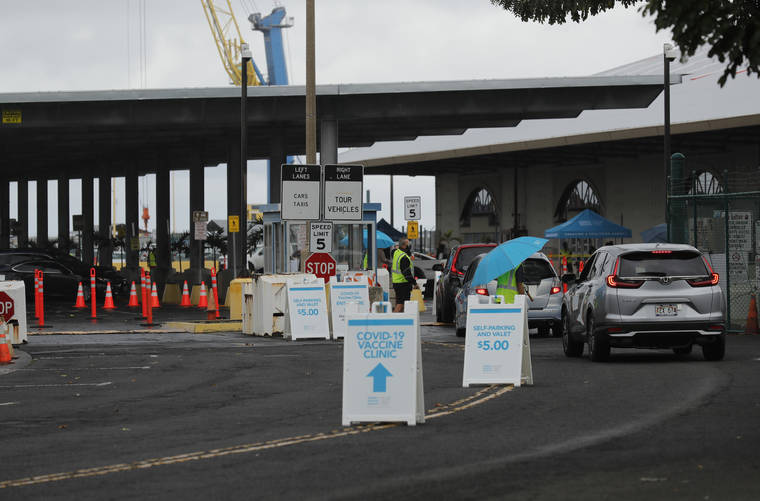It is not over, folks — not by a long shot. And shots, lots more of them, are what’s needed before Hawaii can beat the coronavirus.
The state saw alarming case spikes all last week, to levels not seen since January. Friday was the ninth straight day of triple-digit new daily totals: a disturbing count of 233, with 151 on Oahu, 13 on Maui, 39 on Hawaii island, 12 on Kauai and 18 Hawaii residents diagnosed outside the state.
Of Thursday’s 243 cases statewide, 146 were on Oahu, and 25 diagnosed out of state. That latter group, of Hawaii people bringing back the virus, highlights the need for heightened vigilance and caution when traveling outside our state’s bubble.
Still, it is the imperative to increase vaccinations here that will make the biggest difference against COVID-19, especially the highly transmissible delta variant. Hawaii health officials last week underscored that virtually all of those newly infected with COVID here — 97% — were unvaccinated.
Lamentably, it was just three short weeks ago when optimism was fairly high that Hawaii was on a good path. New daily case counts were fairly stable then, in double- digits, and vaccinations were moving apace. On July 8, with a 60% fully-immunized rate thought to be just around the corner, travel rules were mostly eased for fully vaccinated arrivals — and on Oahu, a restrictive tiered system that had regulated economic reopening was overhauled.
Eager to reactivate the economy, the Blangiardi administration eliminated Oahu’s most-restrictive Tiers 1 to 3, and as posted on oneoahu.org, the forward-only reopening strategy now starts at Tier 4. The new framework, effective July 8 and which now puts Oahu at Tier 5 under looser gathering rules, also diminishes weekly case-count averages as well as positivity rates. Those key metrics since the pandemic’s outset will continue to be monitored, “but will no longer dictate tier movement,” according to an update co-signed by Honolulu Mayor Rick Blangiardi and Gov. David Ige.
Blangiardi emphasized the availability of effective COVID-19 vaccines in pushing the reopening envelope. The Tier 5 relaxations include allowing eateries and bars to have groups of up to 25 indoors or to operate at 100% capacity if customers show proof of vaccination — but that latter requirement has since been rejected by businesses as impractical.
Further, as of Friday, the promise of 60% fully vaccinated had yet to be reached, with rates here significantly stalling the past two weeks; full vaccination stood at 59.6%, at 66.2% for one shot. That’s utterly discouraging, given the ongoing outreach and accessibility of myriad immunization sites in communities.
Clearly, efforts must be redoubled to target low-rate areas, take vaccination clinics into neighborhoods, plus enlist doctors and medical professionals to have immunization conversations with patients. And when schools restart next month, campus-sited mobile clinics need to be deployed in fuller force, from middle school through college.
Blangiardi said his administration is urging union leaders to get more members vaccinated, though added that there is no “clear-cut strategy” to influence Oahu residents resisting immunization. But if the pro-business mayor does not want COVID-19 severity to force an economic backsliding, he must enlist the networks of restaurants, retailers and businesses to press the vaccination message as robustly as the earlier “let us reopen” one.
Hawaii’s increase comes amid a tripling of COVID-19 cases in the U.S. over the past two weeks, as vaccine misinformation and the aggressive delta variant spread, straining hospitals and exhausting health workers in hard-hit areas. Mainland hospitalizations are spiking for the first time in months — with an overwhelming majority of sick patients shown to be unvaccinated.
Florida, Missouri, Louisiana and Texas are particular hotspots — but even West Coast favorites for isle travelers such as Los Angeles and Las Vegas just reinstated indoor mask mandates: L.A. for all inside public spaces, Vegas for all its county employees. Given potential exposure in these higher-risk locales, all Hawaii travelers should be donning masks as much as possible. Hawaii’s Health Department, in fact, last week made note of Hawaii residents traveling to the mainland and back while infected, but without realizing it.
Despite the triple-digits of new COVID cases here, one positive is that they seem to be less severe than before — for now.
“We haven’t seen a corresponding increase in the number of hospitalizations or ICU COVID cases so far, and our health-care capacity is not threatened at this point,” Gov. David Ige said earlier last week. That underscores the effectiveness of the vaccines in containing the severity of COVID-19, even as it circulates in communities.
This is a dangerous virus that’s already killed more than 610,000 Americans, and is now resurging. Keep those masks on indoors — and especially, urge co-workers, families and friends to get vaccinated. That is the best way to keep each other safe, especially our keiki under 12 who cannot do it to protect themselves.

